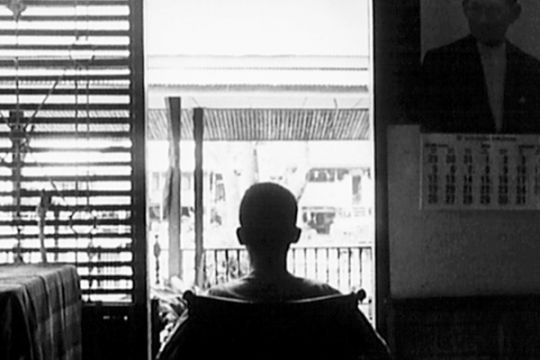Mysterious Object at Noon

Synopsis
The inspiration for Mysterious Object At Noon was the Surrealist storytelling technique known as Exquisite Corpse, wherein a variety of writers would contribute to a story one sentence at a time, without knowing much about what the previous sentences contained. Thai independent filmmaker Apichatpong Weerasethakul used the technique to interview people throughout Thailand, learning a little bit about their lives and then asking them to contribute to the film's evolving story. What emerges is at once a portrait of Thailand's disenfranchised lower classes – farmers, fruit vendors, village performers of "mor lam" (a song-and-storytelling hybrid extremely popular in the rural northeast) – and a fractured group-narration of a story about a handicapped boy and his tutor, a woman named Dogfar. The finished story was then shot in dramatic form, using nonprofessional actors, and intercut with the earlier footage."It's a film unlike any other... you're likely to be utterly enchanted by this unique dish of entertainment that may be the beginning of a new art form: Village Surrealism. Mr. Weerasethakul's film is like a piece of chamber music slowly, deftly expanding into a full symphonic movement." – Elvis Mitchell, The New York Times
"Mysterious Object at Noon engages, unhinges and forever deranges the way that stories and cultural histories could – and perhaps should – be told." – Chuck Stephens, Filmmaker Magazine
"The most remarkable thing about Mysterious Object at Noon is that you can ‘deconstruct’ it – pick it apart – without destroying its magic. Its opening caption is “Once upon a time” but the expectation of a fairy tale is immediately undercut with an extended take, shot from a moving vehicle, of modern Bangkok. As the shot takes us from multi-lane highways and high-rise shopping malls into a soi, a narrow, winding, residential alleyway from an earlier period in the city’s development, we hear two things on the soundtrack. First, from the radio, a trailer for a soap opera called Tomorrow I Will Love You, a torrid saga of a woman battling her unlucky fate to win back the man she loves, typical of the dozens such serials which clog up Thai radio and TV round the clock every day. Second, from a loudspeaker mounted on the roof of a van, a repetitive sales pitch offering both tuna chunks and a special deal on bottles of the pungent fish sauce which is a staple of Thai cuisine. Both are ‘naturalistic’ in the sense that you would expect to hear them in any of Bangkok’s soi, but one refers to a romantic fantasy world far removed from the realities of the streets while the other refers to basic household needs.
The editing suggests that the ‘driving’ shot was taken from the seafood vendor’s van, since we’re next listening to a sorrowful personal history told by the woman who works in the van. While she tells her story Apichatpong cuts away to show other street-scenes, including the election-campaign posters. What do these cutaways signify? That the filmmaker’s attention is wandering? That he isn’t very interested in this all-too-common story of personal hardship and familial injustice? That he wants to broaden the woman’s story by suggesting a connection with patriarchal Thai politics? The answer may well be all of the above, since we next hear Apichatpong’s own voice interrupting the woman’s tale of woe by asking her to tell a story. It’s she who comes up with the character of Dogfahr, tutor-cum-child minder to a boy in a wheelchair whose parents are always absent. She is barely through with her introduction of her characters before Apichatpong cuts away to his own staged enactment of the story she tells. This first instalment concludes with Dogfahr’s physical collapse; it’s when the boy tries to help her that the ball-shaped ‘mysterious object’ rolls out from under her skirt.
There are seven more instalments in Dogfahr’s story, improvised in deliberately varied locations at the ends of trips by road, rail and river. Ranging from Isan in the north to the southern areas near the border with Malaysia, the locations include a timber forest with working elephants to a school for the deaf-mute. All the journeying suggests an underlying desire to create a kind of gazetteer of Thailand in the late 1990s, built with no scientific rigour from these seemingly random spot-samples.
Apichatpong’s work during the long months of editing Mysterious Object at Noon parallels the way that Dogfahr’s story is told by unconnected strangers: his juxtapositions of urban and rural sights, of interviews and improvisations, of social observations and staged enactments all represent attempts to tease unseen dimensions of Thailand’s realities into view.
In its endearingly scattershot way, the film lays out many of the precepts which will inform Apichatpong’s future work. It launches the idea of ‘secret’ continuities from film to film: Dogfahr takes her disputatious father to a doctor for help with his diminishing hearing, and the scenes in a clinic at the start of Blissfully Yours feature an angry old man who accuses his daughter of breaking his hearing aid. It launches the kind of two-part structure which will be explored in the following three features: ‘Mysterious Object’ and ‘At Noon’ reflect back on each other, mapping the space between the structured and the random. It also launches Apichatpong’s exploration of the Thai landscape, both urban and rural, which will become an important element in everything he goes on to do. And it inaugurates Apichatpong’s recurrent use of the tiger as a paradoxical symbol of attraction and danger: the tiger here comes from the mouths of schoolkids, but it soon becomes the prime denizen of the forests of Apichatpong’s imagination." – Tony Rains
Tony Rayns' complete essay, from which this excerpt is taken, appears in the booklet which accompanies Second Run's release.